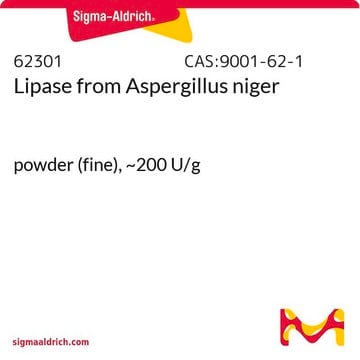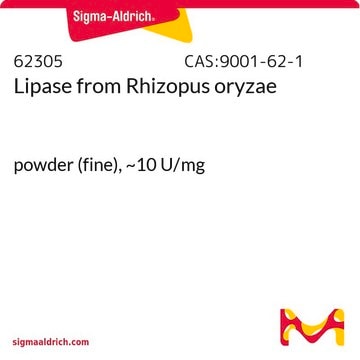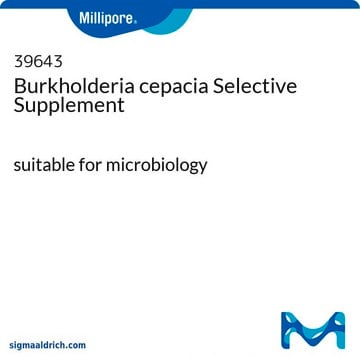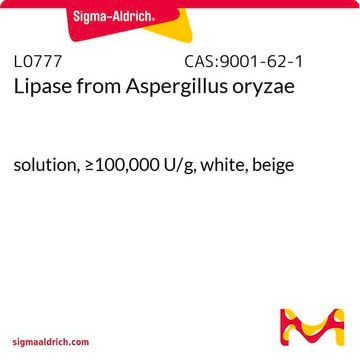62316
Lipase from Candida rugosa
powder, yellow-brown, ≥2 U/mg
Synonym(s):
CCL
About This Item
Recommended Products
biological source
fungus (Candida rugosa)
Quality Level
form
powder
specific activity
≥2 U/mg
mol wt
Mr ~67000
storage condition
dry at room temperature
concentration
≤100%
technique(s)
analytical sample preparation: suitable
color
yellow-brown
pH range
6.5—7.5 (0.01 g/L)
solubility
water: slightly soluble
application(s)
sample preservation
storage temp.
2-8°C
InChI
1S/C11H9N3O2.Na/c15-8-4-5-9(10(16)7-8)13-14-11-3-1-2-6-12-11;/h1-7,16H,(H,12,14);/q;+1/b13-9-;
InChI key
QWZUIMCIEOCSJF-CHHCPSLASA-N
Gene Information
fungus ... LAP1(2544)
Looking for similar products? Visit Product Comparison Guide
General description
The lipase enzyme is a naturally occurring enzyme present in both the stomach and pancreatic juice. It is expressed and active in various tissues. For instance, hepatic lipases are found in the liver, hormone-sensitive lipases in adipocytes, lipoprotein lipase on the vascular endothelial surface, and pancreatic lipase in the small intestine. These lipases are classified within the alpha/beta-hydrolase fold superfamily of enzymes.
Application
Biochem/physiol Actions
Unit Definition
Signal Word
Danger
Hazard Statements
Precautionary Statements
Hazard Classifications
Resp. Sens. 1
Storage Class Code
11 - Combustible Solids
WGK
WGK 1
Flash Point(F)
Not applicable
Flash Point(C)
Not applicable
Personal Protective Equipment
Certificates of Analysis (COA)
Search for Certificates of Analysis (COA) by entering the products Lot/Batch Number. Lot and Batch Numbers can be found on a product’s label following the words ‘Lot’ or ‘Batch’.
Already Own This Product?
Find documentation for the products that you have recently purchased in the Document Library.
Customers Also Viewed
Our team of scientists has experience in all areas of research including Life Science, Material Science, Chemical Synthesis, Chromatography, Analytical and many others.
Contact Technical Service











